Odontomachus
Одонтомахус[2] (лат. Odontomachus, от др.-греч. ὀδοντο- + -μᾰχος «сражающися зубами») — род муравьёв (Formicidae) из подсемейства Ponerinae, включающий тропических и субтропических понерин с длинными жвалами, мгновенно закрывающимися как капканы.
Одонтомахус | ||||||||||||||||||
|---|---|---|---|---|---|---|---|---|---|---|---|---|---|---|---|---|---|---|
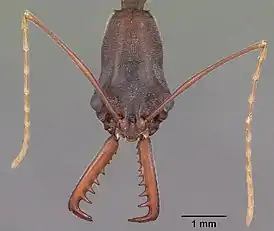 Голова муравья Odontomachus coquereli | ||||||||||||||||||
| Научная классификация | ||||||||||||||||||
|
||||||||||||||||||
| Латинское название | ||||||||||||||||||
| Odontomachus Latreille, 1804 | ||||||||||||||||||
| Синонимы | ||||||||||||||||||
|
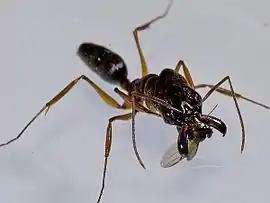
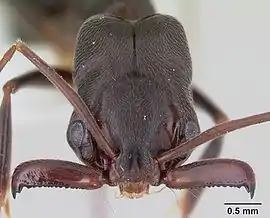

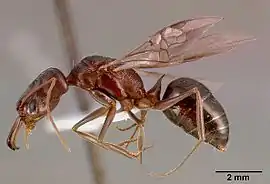
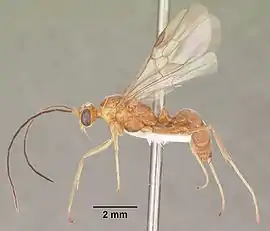
Распространение
Род характерен для тропиков и субтропиков Старого Света (Африка, южная и юго-восточная Азия, Австралия) и Нового Света. Наибольшее разнообразие отмечено в Америке и Азии, в то время как в Африке лишь 2 вида (O. assiniensis и O. troglodytes), а на Мадагаскаре с близлежащими островами три вида (O. coquereli, O. troglodytes, и на Сейшеллах O. simillimus, предположительно интродуцирован). Несколько видов проникают в области с умеренным климатом на юго-запад США, северо-восток Китая, центральную Аргентину[1].
Описание
Длина тела о 6 до 20 мм (в среднем около 1 см). Мандибулы прямые и узкие. Окраска от оранжевой до чёрной. Стебелёк между грудкой и брюшком состоит из 1 членика (петиоль), но первый сегмент брюшка не так резко, как у других понерин отделён перетяжкой от остальных. Заднегрудка без проподеальных зубцов (у сходного рода Anochetus они обычно развиты), Усики рабочих и самок 12-члениковые (у самцов 13). Оцеллии отсутствуют, сложные глаза среднего размера. Нижнечелюстные щупики рабочих 4-члениковые (у самцов 6 или 5), нижнегубные щупики состоят из 4 или 3 сегментов (у самцов 4 или 3). Средние и задние голени с 2 шпорами (одной гребенчатой и одной простой). Жало развито. Куколки в коконах[1][3]. Odontomachus это один из 4 родов муравьёв, способных к прыжкам с помощью ног (наряду с Gigantiops, Myrmecia и Harpegnathos)[4][5][6].
Биология
Хищники, охотящиеся на членистоногих (некоторые специализируются на термитофагии). Часть видов имеют трофобиотические отношения с сосущими соки растений равнокрылыми насекомыми или посещают внецветковые нектарники (O. affinis[7]; O. bauri, O. hastatus, O. panamensis[8][9]; O. troglodytes[10][11]. Неотропический вид O. chelifer известен как поедающий фрукты и части семян, которые он в конечном счете распространяет[12][13][14]. O. laticeps и O. minutus (=O. meinerti) также собирают семена с питательной оболочкой[15]. O. malignus отличается своей привычкой поиска пищи среди кораллов во время отлива[16]. Фуражируют в наземном ярусе. В поисках корма рабочие муравьи O. bauri осуществляют навигацию с помощью визуальных сигналов из верхнего полога леса, а также химические метки[17]. У вида O. troglodytes обнаружена мобилизация соплеменников с помощью тандемного бега[11][3].
Размер колоний сильно варьирует в пределах рода. Минимальное численность в 18 рабочих муравьёв отмечена у вида Odontomachus coquereli[18], а наибольший размер семей в 10000 рабочих обнаружен у вида O. opaciventris[19]. Большинство видов имеет средний размер семей в несколько сотен рабочих муравьёв: колонии O. chelifer содержат от 100 до 650 рабочих[20][14], колонии O. rixosus — в среднем 142 рабочих[21], семьи O. bauri — до 300 рабочих[22], колонии O. troglodytes — более 1,000 рабочих[23][3].
Большинство видов рода Odontomachus имеют типичных крылатых самок и полунезависимый способ основания новых семей[1], однако вид O. coquereli имеет бескрылых эргатоидных самок и колонии по всей видимости репродуцируются путём деления[18]. У неописанного вида из Малайзии также обнаружены эргатоидные самки[24], а деление колонии путём почкования отмечено у некоторых других видов[1]. Часть видов Odontomachus имеют в семьях только одну матку (моногиния), но у других известна полигиния, например, у O. assiniensis[25]; O. cephalotes[26]; O. chelifer[27]; O. rixosus[21]; O. troglodytes[25]. Самки O. rixosus демонстрируют набор задач более характерный для рабочей касты, включая фуражировку за пределами гнезда[21][3].
Гнезда и мирмекофилы
Муравьи этого рода строят земляные гнезда (а также древесные и в термитниках), состоящие всего из нескольких крупных камер. Большинство видов гнездятся в почве или в гнилой древесине (например, Odontomachus affinis[28]; O. bauri[29]; O. brunneus, O. clarus, O. relictus и O. ruginodis[30]; O. cephalotes[16]; O. chelifer[20][14]; O. coquereli[18]; O. erythrocephalus[9]; O. opaciventris[19]; O. rixosus[21]; O. simillimus[16][31]; O. tyrannicus[16]), некоторые виды гнездятся в покинутых термитниках ([32]) или арбореально (например, O. troglodytes[23]; O. brunneus, O. hastatus, и O. mayi[1]; O. bauri и O. hastatus[9]). Гнёзда O. bauri предположительно полидомные ([29])[3].
Среди паразитоидов обнаружены паразитические наездники (Eucharitidae) видов Chalcura deprivata, Kapala terminalis и Schizaspidia convergens[33]. В гнёздах Odontomachus monticola (Китай) найдены мирмекофильные жуки Pengzhongiella daicongchaoi[34].
Генетика
Диплоидный набор хромосом 2n = 30, 32 и 44[35].
Геном у разных видов рода варьирует в следующих пределах[36]:
Классификация
Род имеет несколько синонимов (Champsomyrmex Emery, 1892, Myrtoteras Matsumura, 1912, Pedetes Bernstein, 1861) и включает около 70 видов, в том числе, ископаемые[42].
Группы видов
Выделяют 13 групп видов[1][43][44].
- Группа Odontomachus assiniensis. Африка, 1 вид
- Группа Odontomachus bradleyi. Южная Америка, 1 вид
- Группа Odontomachus coquereli. Мадагаскар, 1 вид
- Группа Odontomachus cornutus. Южная Америка, 1 вид
- Группа Odontomachus infandus. Юго-Восточная Азия, Океания. Более 10 видов
- Группа Odontomachus hastus. Южная Америка, 1 вид
- Группа Odontomachus haematodus. Повсеместно. Более 20 видов
- Группа Odontomachus malignus. Юго-Восточная Азия, Океания. 2 вида
- Группа Odontomachus mormo. Южная Америка, 1 вид
- Группа Odontomachus rixosus. Юго-Восточная Азия. 8 видов
- Группа Odontomachus ruficeps. Австралия, Меланезия, 3 вида
- Группа Odontomachus saevissimus. Меланезия, 5 видов
- Группа Odontomachus tyrannicus. Меланезия, 3 вида
Список видов
- Odontomachus aciculatus F. Smith, 1863
- Odontomachus affinis Guerin-Meneville, 1844
- Odontomachus alius Sorger & Zettel, 2011[43]
- Odontomachus allolabis Kempf, 1974
- Odontomachus angulatus Mayr, 1866
- Odontomachus animosus Smith, 1860
- Odontomachus assiniensis Emery, 1892
- Odontomachus banksi Forel, 1910
- Odontomachus bauri Emery, 1892 (Центральная и Южная Америка)
- Odontomachus biolleyi Forel, 1908
- Odontomachus biumbonatus Brown, 1976[1]
- Odontomachus bradleyi Brown, 1976
- Odontomachus brunneus (Patton, 1894)
- Odontomachus caelatus Brown, 1976
- Odontomachus cephalotes F. Smith, 1863 (Индонезия, Австралия)
- Odontomachus chelifer (Latreille, 1802)
- Odontomachus circulus Wang, 1993[45]
- Odontomachus clarus Roger, 1861
- Odontomachus coquereli Roger, 1861
- Odontomachus cornutus Stitz, 1933
- Odontomachus davidsoni Hoenle et al., 2020[46]
- Odontomachus desertorum Wheeler, 1915
- Odontomachus erythrocephalus Emery, 1890
- Odontomachus floresensis Brown, 1976[1]
- Odontomachus fulgidus Wang, 1993[45]
- Odontomachus granatus Wang, 1993[45]
- Odontomachus haematodus (Linnaeus, 1758) (Южная Америка, интродуцирован в Австралию, около 1876)
- Odontomachus hastatus (Fabricius, 1804)
- Odontomachus imperator Emery, 1887
- Odontomachus infandus Smith, 1858
- Odontomachus insularis Guérin-Méneville, 1844
- Odontomachus kuroiwae (Matsumura, 1912)
- Odontomachus laticeps Roger, 1861
- Odontomachus latidens Mayr, 1867
- Odontomachus latissimus Viehmeyer, 1914
- Odontomachus malignus Smith, 1859
- Odontomachus mayi Mann, 1912
- Odontomachus meinerti Forel, 1905
- Odontomachus montanus Stitz, 1925
- Odontomachus monticola Emery, 1892
- Odontomachus mormo Brown, 1976[1]
- Odontomachus nigriceps Smith, 1860
- Odontomachus opaciventris Forel, 1899
- Odontomachus opaculus Viehmeyer, 1912
- †Odontomachus paleomyagra Wappler, Dlussky, Engel, Prokop & Knor, 2014[47][48]
- Odontomachus panamensis Forel, 1899
- Odontomachus papuanus Emery, 1887
- Odontomachus peruanus Stitz, 1933
- Odontomachus philippinus Emery, 1893
- †Odontomachus pseudobauri (De Andrade, 1994)[42]
- Odontomachus relictus Deyrup & Cover, 2004[30]
- Odontomachus rixosus Smith, 1857
- Odontomachus ruficeps Smith, 1858
- Odontomachus rufithorax Emery, 1911
- Odontomachus ruginodis Smith, 1937
- Odontomachus saevissimus Smith, 1858
- Odontomachus scalptus Brown, 1978
- Odontomachus schoedli Sorger & Zettel, 2011[43]
- Odontomachus scifictus Sorger & Zettel, 2011[43]
- Odontomachus silvestrii W.M. Wheeler, 1927
- Odontomachus simillimus F. Smith, 1858
- †Odontomachus spinifer De Andrade, 1994[42]
- Odontomachus spissus Kempf, 1962
- Odontomachus sumbensis Brown, 1976[1]
- Odontomachus tensus Wang, 1993
- Odontomachus testaceus Emery, 1897
- Odontomachus troglodytes Santschi, 1914
- Odontomachus turneri Forel, 1900
- Odontomachus tyrannicus Smith, 1859
- Odontomachus xizangensis Wang, 1993[45]
- Odontomachus yucatecus Brown, 1976[1]
Мандибулы и прыжки
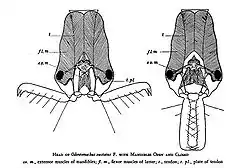

Эти муравьи имеют длинные, узкие и быстро закрывающиеся верхние челюсти. У муравья Odontomachus bauri зафиксирована рекордная для животных скорость защёлкивания мандибул: от 126 до 230 км/час, за 130 микросекунд. С помощью челюстей, муравей может прыгать на высоту до 20 см[49][50][51][52]. Сходный механизм челюстей развит у близкого рода Anochetus[53].
Мирмекоморфия
У прыгающих пауков рода Enoplomischus (Salticidae) наблюдается сходная внешняя форма задней части тела (Мимикрия).
Примечания
- Brown W. L. Contributions toward a reclassification of the Formicidae. VI. Ponerinae, tribe Ponerini, subtribe Odontomachiti. Section A. Introduction, subiribal characters. Genus Odontomachus (англ.) // Studia Entomologica (N.S.) : Журнал. — 1976. — Vol. 19. — P. 67—171.
- Стриганова Б. Р., Захаров А. А. Пятиязычный словарь названий животных: Насекомые (латинский-русский-английский-немецкий-французский) / Под ред. д-ра биол. наук, проф. Б. Р. Стригановой. — М.: РУССО, 2000. — С. 293. — 1060 экз. — ISBN 5-88721-162-8.
- Schmidt C. A., Shattuck S. O. The Higher Classification of the Ant Subfamily Ponerinae (Hymenoptera: Formicidae), with a Review of Ponerine Ecology and Behavior (англ.) // Zootaxa : Журнал. — Auckland, New Zealand: Magnolia Press, 2014. — Vol. 3817(1). — P. 1—242. — ISSN 1175-5326.
- Magdalena Sorger. Snap! Trap-jaw ants in Borneo also jump using their legs (англ.) // Frontiers in Ecology and the Environment : Журнал. — Washington: The Ecological Society of America, 2015. — Vol. 13, no. 10. — P. 574—575. — ISSN 1540-9309. — doi:10.1890/1540-9295-13.10.574.
- Sindya N. Bhanoo. Ants With Leaping Ability. nytimes.com — 1 декабря 2015.
- Jason Bittel. The High-Flying Ant With a Bite Like a Bear Trap. nationalgeographic.com — 20 июня 2014
- Borgmeier, T. (1920) Zur lebensweise von Odontomachus affinis Guérin. Zeitschrift des Deutschen Vereins für Wissenschaft und Kunst in São Paulo, 1, 31–38.
- Schemske D. W. (1982) Ecological correlates of a neotropical mutualism: ant assemblages at Costus extrafloral nectaries. Ecology, 63 (4), 932–941. https://dx.doi.org/10.2307/1937233
- Longino, J.T. (2013) Ants of Costa Rica. Available from: http://academic.evergreen.edu/projects/ants/AntsofCostaRica.html (accessed 10 November 2013)
- Evans, H.C. & Leston, D. (1971) A ponerine ant (Hym. Formicidae) associated with Homoptera on cocoa in Ghana. Bulletin of Entomological Research, 61, 357–362. https://dx.doi.org/10.1017/s0007485300057898
- Lachaud, J.-P. & Déjean, A. (1991a) Food sharing in Odontomachus troglodytes (Santschi): a behavioral intermediate stage in the evolution of social food exchange in ants. Anales de Biología, 17 (6), 53–61.
- Pizo M. A. & Oliveira, P.S. (1998) Interaction between ants and seeds of a nonmyrmecochorous neotropical tree, Cabralea canjerana (Meliaceae), in the Atlantic forest of southeast Brazil. American Journal of Botany, 85 (5), 669–674. https://dx.doi.org/10.2307/2446536
- Passos, L. & Oliveira, P.S. (2002) Ants affect the distribution and performance of seedlings of Clusia criuva, a primarily birddispersed rain forest tree. Journal of Ecology, 90 (3), 517–528. https://dx.doi.org/10.1046/j.1365-2745.2002.00687.x
- Passos, L. & Oliveira, P.S. (2004) Interaction between ants and fruits of Guapira opposita (Nyctaginaceae) in a Brazilian sandy plain rainforest: ant effects on seeds and seedlings. Oecologia, 139, 376–382. https://dx.doi.org/10.1007/s00442-004-1531-5
- Horvitz, C.C. (1981) Analysis of how ant behaviors affect germination in a tropical myrmecochore Calathea microcephala (P. & E.) Koernicke (Marantaceae): microsite selection and aril removal by neotropical ants, Odontomachus, Pachycondyla, and Solenopsis (Formicidae). Oecologia, 51, 47–52. https://dx.doi.org/10.1007/bf00344651
Horvitz, C.C. & Beattie, A.J. (1980) Ant dispersal of Calathea (Marantaceae) seeds by carnivorous ponerines (Formicidae) in a tropical rain forest. American Journal of Botany, 67 (3), 321–326. https://dx.doi.org/10.2307/2442342 - Wilson, E.O. (1959b) Studies on the ant fauna of Melanesia V. The tribe Odontomachini. Bulletin of the Museum of Comparative Zoology, 120, 483–510.
- Oliveira P. S. & Hölldobler, B. (1989) Orientation and communication in the neotropical ant Odontomachus bauri Emery (Hymenoptera, Formicidae, Ponerinae). Ethology, 83 (2), 154–166. https://dx.doi.org/10.1111/j.1439-0310.1989.tb00525.x
- Molet, M., Peeters, C. & Fisher, B.L. (2007) Permanent loss of wings in queens of the ant Odontomachus coquereli from Madagascar. Insectes Sociaux, 54, 183–188. https://dx.doi.org/10.1007/s00040-007-0930-0
- De la Mora, A., Pérez-Lachaud, G. & Lachaud, J.P. (2008) Mandible strike: The lethal weapon of Odontomachus opaciventris against small prey. Behavioral Processes, 78, 64–75. https://dx.doi.org/10.1016/j.beproc.2008.01.011
- Fowler, H.G. (1980) Populations, prey capture and sharing, and foraging of the Paraguayan ponerine Odontomachus chelifer Latreille. Journal of Natural History, 14 (1), 79–84. https://dx.doi.org/10.1080/00222938000770081
- Ito, F., Yusoff, N.R. & Idris, A.H. (1996) Colony composition and queen behavior in polygynous colonies of the Oriental ponerine ant Odontomachus rixosus (Hymenoptera Formicidae). Insectes Sociaux, 43, 77–86. https://dx.doi.org/10.1007/bf01253958
- Jaffe K. & Marcuse, M. (1983) Nestmate recognition and territorial behaviour in the ant Odontomachus bauri Emery (Formicidae: Ponerinae). Insectes Sociaux, 30 (4), 466–481. https://dx.doi.org/10.1007/bf02223978
- Colombel, P.P. (1972) Recherches sur la biologie et l’éthologie d’Odontomachus haematodes L. (Hym. Formicoidea, Poneridae) biologie des ouvrieres. Insectes Sociaux, 3, 171–194. https://dx.doi.org/10.1007/bf02226625
- Gobin B., Ito F., Peeters C. & Billen J. (2006) Queen-worker differences in spermatheca reservoir of phylogenetically basal ants. Cell Tissue Research, 326, 169–178. https://dx.doi.org/10.1007/s00441-006-0232-2
- Ledoux A. (1952) Recherches préliminaires sur quelques points de la biologie d’Odontomachus assiniensis Latr. (Hym. Formicoidea). Annales des Sciences Naturelles-Zoologie et Biologie Animale, 14 (11), 231–248.
- Peeters C. (1987) The diversity of reproductive systems in Ponerine ants. In: Eder, J. & Rembold, H. (Eds.), Chemistry and Biology of Social Insects. Verlag J. Peperny, München, pp. 253–254.
- Medeiros F.N.S., Lopes, L.E., Moutinho, P.R.S., Oliveira, P.S. & Hölldobler, B. (1992) Functional polygyny, agonistic interactions and reproductive dominance in the neotropical ant Odontomachus chelifer (Hymenoptera, Formicidae, Ponerinae). Ethology, 91, 134–146. https://dx.doi.org/10.1111/j.1439-0310.1992.tb00857.x
- Brandão, C.R.F. (1983) Sequential ethograms along colony development of Odontomachus affinis Guérin (Hymenoptera, Formicidae, Ponerinae). Insectes Sociaux, 30 (2), 193–203. https://dx.doi.org/10.1007/bf02223869
- Ehmer, B. & Hölldobler, B. (1995) Foraging behavior of Odontomachus bauri on Barro Colorado Island, Panama. Pysche, 102, 215–224. https://dx.doi.org/10.1155/1995/27197
- Deyrup, M. & Cover, S. (2004) A new species of Odontomachus ant (Hymenoptera: Formicidae) from inland ridges of Florida, with a key to Odontomachus of the United States. Florida Entomologist, 87 (2), 136–144. https://dx.doi.org/10.1653/0015-4040(2004)087[0136:ansooa]2.0.co;2
- van Walsum, E., Gobin, B., Ito, F. & Billen, J. (1998) Worker reproduction in the ponerine ant Odontomachus simillimus (Hymenoptera: Formicidae). Sociobiology, 32 (3), 427–440.
- Déjean, A., Durand, J.L. & Bolton, B. (1996) Ants inhabiting Cubitermes termitaries in African rain forest. Biotropica, 28, 701–713. https://dx.doi.org/10.2307/2389056
Déjean, A., Bolton, B. & Durand, J.L. (1997) Cubitermes subarquatus termitaries as shelters for soil fauna in African rainforests. Journal of Natural History, 31, 1289–1302. https://dx.doi.org/10.1080/00222939700770711 - Kapala Cameron, 1884 (англ.). Universal Chacidoiod Database. Дата обращения: 10 марта 2012. Архивировано 16 мая 2012 года.
- Yin Z. W., Li L. Z. Pengzhongiella daicongchaoi gen. et sp. n., a remarkable myrmecophile (Staphylinidae, Pselaphinae, Batrisitae) from the Gaoligong Mountains. (англ.) // ZooKeys. — 2013. — No. 326. — P. 17—26. — doi:10.3897/zookeys.326.5933. — PMID 24039533.
- Lorite P.& Palomeque T. Karyotype evolution in ants (Hymenoptera: Formicidae) with a review of the known ant chromosome numbers (англ.) // Myrmecologische Nachrichten : Журнал. — Wien, 2010. — Vol. 13. — P. 89—102.
- Tsutsui Neil D, Suarez Andrew V, Spagna Joseph C, Johnston J Spencer. The evolution of genome size in ants // BMC Evolutionary Biology. — 2008. — Т. 8, № 1. — С. 64. — ISSN 1471-2148. — doi:10.1186/1471-2148-8-64.
- База данных о размерах геномов животных — Odontomachus bauri.
- База данных о размерах геномов животных — Odontomachus brunneus.
- База данных о размерах геномов животных — Odontomachus cephalotes.
- База данных о размерах геномов животных — Odontomachus chelifer.
- База данных о размерах геномов животных — Odontomachus haematodus.
- De Andrade, M. L. 1994c. Fossil Odontomachiti ants from the Dominican Republic (Amber Collection Stuttgart: Hymenoptera, Formicidae. VII: Odontomachiti). Stuttg. Beitr. Naturkd. Ser. B (Geol. Paläontol.) 199: 1-28
- Sorger, D.M. and H. Zettel. On the ants (Hymenoptera: Formicidae) of the Philippine Islands: V. The genus Odontomachus Latreille, 1804 (англ.) // Myrmecological News : Журнал. — 2011. — Vol. 14. — P. 141-163.
- Wang W. Y., Yamada A., Yamane S. Maritime trap-jaw ants (Hymenoptera, Formicidae, Ponerinae) of the Indo-Australian region – redescription of Odontomachus malignus Smith and description of a related new species from Singapore, including first descriptions of males (англ.) // ZooKeys : Журнал. — Sofia: Pensoft Publishers, 2020. — Vol. 915. — P. 137–174. — ISSN 1313-2970. — doi:10.3897/zookeys.915.38968.
- Wang M. Taxonomic study of the ant tribe Odontomachini in China (Hymenoptera: Formicidae) (англ.) // Sci. Treatise Syst. Evol. Zool. : Журнал. — 1993. — Vol. 2. — P. 219-230.
- Hoenle P., Lattke J.E., Donoso, D., von Beeren, C., Heethoff, M., Schmelzle, S., Argoti, A., Camacho, L.F., Ströbel, B., Blüthgen, N. 2020. Odontomachus davidsoni sp. nov. (Hymenoptera, Formicidae), a new conspicuous trap-jaw ant from Ecuador. ZooKeys, 948: 75–105. DOI: 10.3897/zookeys.948.48701
- Wappler, T., Dlussky, G.M., Engel, M.S., Prokop, J. & Knor, S. 2014. A new trap-jaw ant species of the genus Odontomachus (Hymenoptera: Formicidae: Ponerinae) from the Early Miocene (Burdigalian) of the Czech Republic. Paläontologische Zeitschrift, 88, 495–502.
- An Online Catalog of the Ants of the World: O. paleomyagra
- Ant Jaws Break Speed Record — Videos of Odontomachus jumping using its jaws
- Patek S.N., Baio J.E., Fisher B.L., Suarez A.V. Multifunctionality and mechanical origins: Ballistic jaw propulsion in trap-jaw ants (англ.) // Proceedings of the National Academy of Sciences : journal. — 2006. — 22 August (vol. 103, no. 34). — P. 12787—12792. — doi:10.1073/pnas.0604290103. — PMID 16924120.
- Spagna, J. C., Larabee, F. J., Suarez, A. V. Evolution of jaw-morphology and kinematics in ponerine trap-jaw ants // Integrative and Comparative Biology. — 2012. — No. 52. — P. 165.
- Spagna, JC; Patek, SN; Suarez, AV. Polymorphic trap-jaws: intra- and interspecific scaling of jaw forces in trap-jaw ants // Integrative and Comparative Biology. — 2009. — No. 49. — P. 160. — ISSN 1540-7063.
- Gronenberg, W.; Ehmer, B. The mandible mechanism of the ant genus Anochetus (Hymenoptera, Formicidae) and the possible evolution of trap-jaws // Zoology. — 1996. — Vol. 99, no. 3. — P. 153—162.
Литература
- Bolton B., A new general catalogue of the ants of the world, Harvard University Press, Cambridge, MA, 1995.
- Patek S. N., J. E. Baio, B. L. Fisher and A. V. Suarez. Multifunctionality and mechanical origins: ballistic jaw propulsion in trap-jaw ants (англ.) // Proceedings of the National Academy of Sciences : Журнал. — National Academy of Sciences, 2006. — Vol. 104, no. 34. — P. 12787—12792.
- Brown W. L. Contributions toward a reclassification of the Formicidae. VI. Ponerinae, tribe Ponerini, subtribe Odontomachiti. Section A. Introduction, subiribal characters. Genus Odontomachus (англ.) // Studia Entomologica (N.S.) : Журнал. — 1976. — Vol. 19. — P. 67—171.
- Brown W. L. Contributions toward a reclassification of the Formicidae. VI. Ponerinae, tribe Ponerini, subtribe Odontomachiti. Section B. Genus Anochetus and bibliography (англ.) // Studia Entomologica (N.S.) : Журнал. — 1978. — Vol. 20, no. 1—4. — P. 549—638.
- MacGown J.A. et al. A review of the Nearctic Odontomachus (Hymenoptera: Formicidae: Ponerinae) with a treatment of the males (англ.) // Zootaxa : Журнал. — 2014. — Vol. 3802(4). — P. 515–552. — doi:10.11646/zootaxa.3802.4.6.
